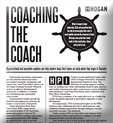 CEOs and executives helm the ship by encouraging their crew to work together and use resources at hand. Although some guide their teams safely to their destination, others end up lost at sea. Organizational and executive coaches can help leaders keep their teams on track when they begin to flounder.
CEOs and executives helm the ship by encouraging their crew to work together and use resources at hand. Although some guide their teams safely to their destination, others end up lost at sea. Organizational and executive coaches can help leaders keep their teams on track when they begin to flounder.5 Suggestions from the Hogan Coaching Network for Building an Effective Development Framework
1. Provide education and training. Formal programs, classes, or workshops; coaching; mentoring; webinars; or on-the-job training are all valuable resources to build and reinforce an employee’s skills and improve performance.
2. Leverage strengths. If a leader lacks creative and innovative ability but excels in effective teambuilding, he or she can leverage his or her ability to create an environment that facilitates and nurtures the team’s new and different ideas.
3. Compensate with alternative behaviors. Use positive behaviors to rebuild a reputation marked by counterproductive behaviors. As positive behaviors are demonstrated multiple times, the manager’s reputation will begin to change, and often new behaviors become the person’s natural behaviors.
4. Support weakness with resources. When someone has a clear weakness, such as micromanaging, sometimes the most effective development strategy is to compensate by supporting the employee with additional resources, such as a direct report who excels at dotting the I’s and crossing the T’s.
5. Redesign the job or assignment. More effective than allowing an individual’s performance to flag, it is sometimes possible to alter an individual’s job requirements to remove key roles or responsibilities and assign him or her elsewhere in the organization.
Read the full paper.